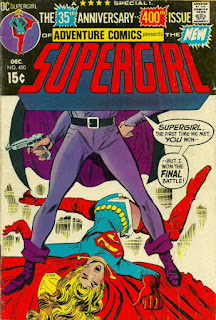We begin with Batman in "Your Servant of Death -- Dr. Darrk" by Denny O'Neil, Bob Brown and Frank Giacoia. When shipping magnate Count Orsoni is attacked and almost killed, Bruce Wayne decides to visit the man, who is an old friend. Upon arriving at the Count's castle in the foreign country he resides, Bruce is welcomed by Mara Thursday, the Count's cousin and Dr. Darrk, one of Orsoni's friends. However, Bruce is not allowed to see the Count, although he is invited to stay in the place.
Having previously stopped the League of Assassins from murdering another shipping magnate, Bruce decides to investigate the case as Batman and he starts prowling the castle, looking for the Count. He is distracted when Mara Thursday screams in her room and when Batman enters, she makes up a story about an attacker that left without harming her. Batman deduces that this was all a distraction and he rushes to the Count's chambers, but he finds nothing but an empty room.
Batman deduces that the Count was kidnapped recently and he starts looking in the castle, when he is suddenly attacked by another member of the League of Assassins. Batman manages to defeat the assassin and he proceeds to look on the hidden places of the castle. Batman finally reaches the cellar, where he finds the Count but falls for a trap and is forced to lay on top of an execution altar. Batman deduces the identity of the killer as Dr. Darrk and he reveals himself as the president of the League of Assassins and prepares Batman for his execution.
Batman is shackled to the altar and forced to hold a rope that keeps an axe from beheading him. Dr. Darrk leaves with the certainty that Batman's grip will surely fail and he forgets about the Count. As Batman in fact starts losing his strength, the Count recovers and, crawling aimlessly, he pushes the statue of a saint on top of the altar, which falls near Batman's head at the same time as he lets go of the rope. The axe falls on the statue, saving Batman's life and the shackles are broken by the impact.
Batman takes the Count to safety, but by the time he goes to the main rooms of the castle, he finds only the assassin he previously defeated and Mara Thursday. Darrk has left the place long ago and Batman arrests Mara and the assassin, who confess all they know about the League, which is not much. This story was reprinted in Showcase Presents: Batman Vol. 5 TPB (2012).
The backup story is Batgirl in "The Explosive Circle" by Frank Robbins, Gil Kane and Vince Colletta. When a residential building is blown up, the sole clue is a book taken out from Gotham Public Library. Finding the book is popular among young hippies/protesters, Barbara Gordon decides to investigate further as Batgirl. Tracing the address of the last person to take out the book in question, Batgirl finds that it belongs to a girl who is a member of the youth group Peaceful Protest. However, when Batgirl informs her the book was found at the site of a bombing, the girl freaks out and slams the door on Batgirl.
Tailing the young woman to a theater known as "Up Against the Wall Baby", Batgirl soon stumbles upon the groups leader Mal who has decided peaceful protesting no longer works and wants to begin using more violent methods. Finding Batgirl at their latest rally, she is knocked out during a performance and when she comes too, she finds that Mal has placed her in a room rigged to explode should she step out of the circle she is standing on. Obviously, continued next issue. This story was reprinted in Showcase Presents: Batgirl Vol. 1 TPB (2007) and Batgirl: The Bronze Age Omnibus Vol. 1 HC (2018).
Edited by Julius Schwartz.

































